Looking to ease stress through knitting? Try these seven calming methods: Start with the slow and steady garter stitch for a meditative experience. Move on to rhythmic stockinette meditation to enhance focus and reduce anxiety. Explore soothing textured patterns like seed or moss stitch for tactile engagement. Embrace the continuous flow of circular knitting for immersion. Practice mindful color therapy by choosing hues that evoke positive emotions. Synchronize your breathing with your stitching to deepen mindfulness. Finally, ground yourself through cable work, which requires focus and presence. These techniques offer a range of ways to find tranquility in your craft. Discover how each method can transform your knitting into a powerful stress-relief tool.
Slow and Steady Garter Stitch
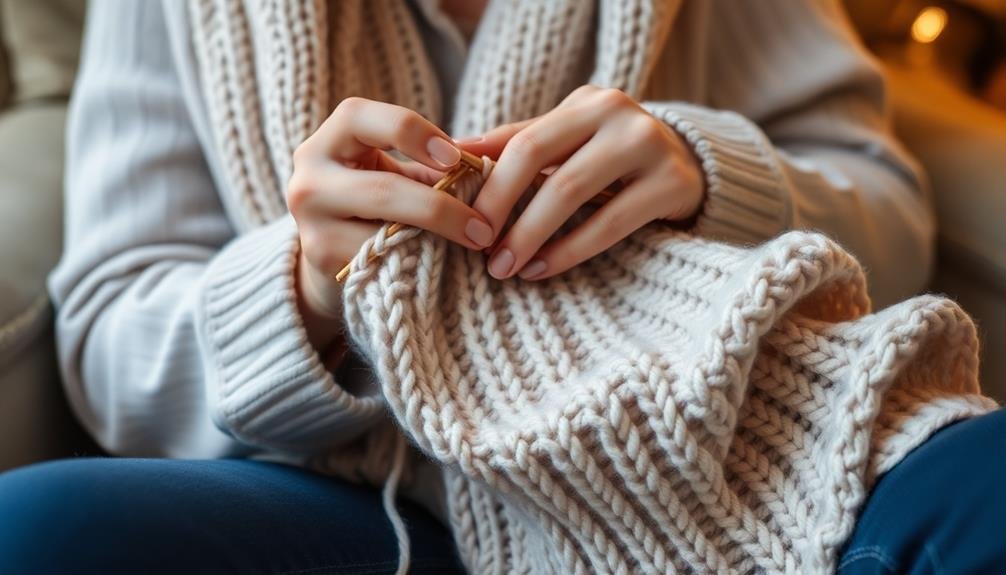
When it comes to calming knitting methods, the slow and steady garter stitch is a perfect place to start. This simple technique involves knitting every row, creating a sturdy, reversible fabric with a distinctive ridged texture. It's an ideal choice for beginners and experienced knitters alike who seek a meditative, stress-relieving activity.
To begin, cast on your desired number of stitches using needles appropriate for your yarn weight. As you knit each row, focus on maintaining a consistent tension and rhythm. The repetitive nature of garter stitch allows your mind to enter a peaceful state, similar to meditation.
You'll find that garter stitch projects progress slowly, which can be a blessing in disguise. This unhurried pace encourages you to be present in the moment, savoring each stitch and the tactile sensation of the yarn sliding through your fingers. It's an excellent opportunity to practice mindfulness and let go of daily stresses.
Consider starting with a simple scarf or dishcloth to experience the calming effects of garter stitch. As you become more comfortable, you can incorporate this technique into larger projects or combine it with other stitches for added interest.
Rhythmic Stockinette Meditation
Focus on the soothing repetitive motion of stockinette stitch to enter a meditative state.
You'll find your mind settling into a calm rhythm as you alternate between knit and purl rows.
Soothing Repetitive Motion
The gentle, rhythmic motion of knitting stockinette stitch can transport you into a meditative state. As you work row after row, your hands move in a soothing, repetitive pattern that calms your mind and body. This simple yet effective technique allows you to focus on the present moment, letting go of stress and worries.
To maximize the calming effects of stockinette stitch, try these tips:
- Choose soft, comfortable yarn that feels good in your hands.
- Use needles that suit your preferred knitting style.
- Find a quiet, comfortable space to knit.
- Set a timer for 15-30 minutes to start, gradually increasing as desired.
The benefits of this meditative knitting practice are numerous:
| Mental Benefits | Physical Benefits |
|---|---|
| Reduced anxiety | Lowered heart rate |
| Improved focus | Decreased muscle tension |
| Enhanced mood | Better sleep quality |
| Increased creativity | Improved hand dexterity |
Mindful Focus Technique
Building on the soothing repetitive motion of stockinette stitch, you can deepen your meditative practice through the Mindful Focus Technique. This method combines the rhythmic action of knitting with mindfulness principles to create a powerful stress-relief tool.
To begin, choose a simple stockinette project and find a quiet, comfortable space. As you knit, focus your attention on each stitch. Notice the tension in the yarn, the click of the needles, and the fabric forming in your hands. When your mind wanders, gently bring it back to the present moment and your knitting.
Count your stitches silently, coordinating your breath with the rhythm. Inhale as you insert the needle, exhale as you wrap the yarn. This syncing of breath and movement enhances relaxation and concentration.
As you practice, you'll likely experience a state of flow where time seems to slow down. Embrace this sensation, allowing stress and worries to fade away.
The Mindful Focus Technique not only produces a beautiful knitted item but also cultivates a sense of calm and presence that can extend beyond your knitting sessions.
Soothing Textured Patterns
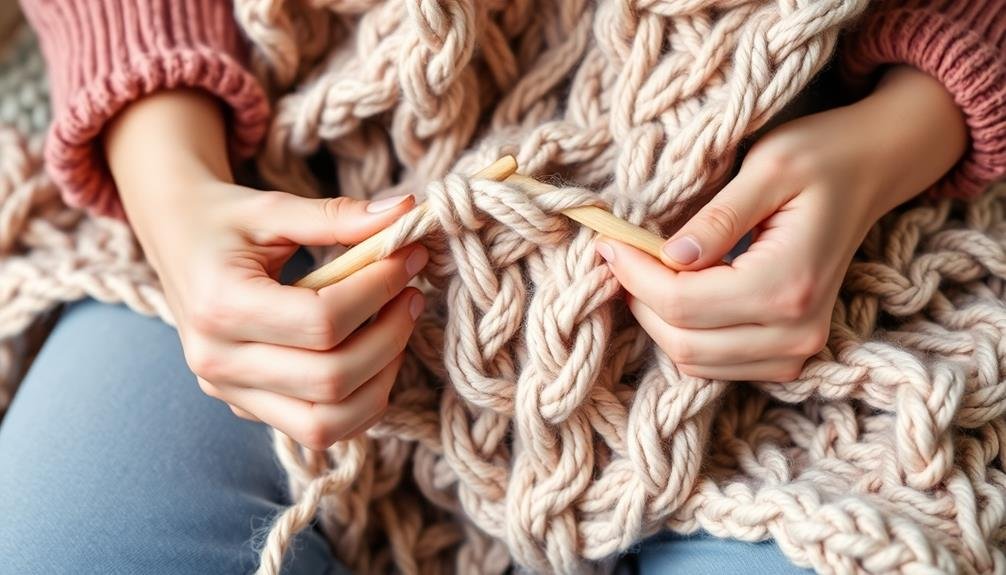
Texture plays an essential role in creating calming knitting patterns. When you're looking to reduce stress through knitting, consider incorporating soothing textured patterns into your projects. These patterns engage your senses and provide a tactile experience that can help you relax and unwind.
Try experimenting with different stitch combinations to create interesting textures. Some popular options include:
| Stitch Pattern | Difficulty | Calming Effect |
|---|---|---|
| Seed Stitch | Easy | High |
| Moss Stitch | Easy | High |
| Basketweave | Moderate | Moderate |
| Cable Knit | Advanced | High |
The repetitive nature of these textured patterns can induce a meditative state, helping you focus on the present moment. As you work through each stitch, you'll feel the tension in your body release. The seed and moss stitches are particularly soothing due to their simple yet engaging patterns. For a more challenging experience, try the basketweave or cable knit patterns, which require more concentration but offer a satisfying textural result.
Remember to choose yarns with a pleasant feel, such as soft wool or cotton blends, to enhance the calming effect of your knitting project.
Circular Knitting Flow
Circular knitting offers a unique flow that can enhance your relaxation while crafting.
You'll find yourself in a continuous rhythmic motion as you work round after round, creating a seamless project.
This repetitive process encourages mindfulness, allowing you to focus on the pattern and let go of daily stresses.
Continuous Rhythmic Motion
The gentle clacking of needles sets the stage for a meditative knitting experience. As you engage in circular knitting, you'll find that the continuous rhythmic motion creates a soothing flow that can help ease your mind and reduce stress.
Unlike flat knitting, where you need to turn your work at the end of each row, circular knitting allows you to work in a seamless spiral. This uninterrupted motion promotes a state of flow, where you're fully immersed in the task at hand.
You'll find yourself falling into a comfortable rhythm as your hands move in a repetitive pattern. The consistent motion of working stitches around the circular needle can help quiet your thoughts and focus your mind.
To maximize the calming effects, try to maintain a steady pace and breathe deeply as you knit. Pay attention to the feel of the yarn sliding through your fingers and the subtle click of the needles.
This mindful approach can turn your knitting session into a form of moving meditation, allowing you to unwind and release tension with each stitch you create.
Mindful Pattern Repetition
Patterns in circular knitting offer a unique opportunity for mindful repetition. As you work in the round, you'll find yourself falling into a soothing rhythm, repeating the same stitches over and over. This repetitive motion can help quiet your mind and bring your focus to the present moment.
To enhance the calming effects, choose a pattern with a simple, repeating sequence. A basic stockinette or ribbing stitch works well for beginners, while more experienced knitters might opt for a lace or cable pattern.
As you knit, pay attention to each stitch you make. Notice the feel of the yarn between your fingers and the sound of the needles clicking together.
When your mind starts to wander, gently bring your attention back to the pattern. Count your stitches or repeat a calming mantra as you work. You'll find that this mindful approach not only improves your knitting but also helps reduce stress and anxiety.
The circular nature of the project allows you to maintain this flow without interruption, creating a meditative experience that can last for hours.
Mindful Color Therapy
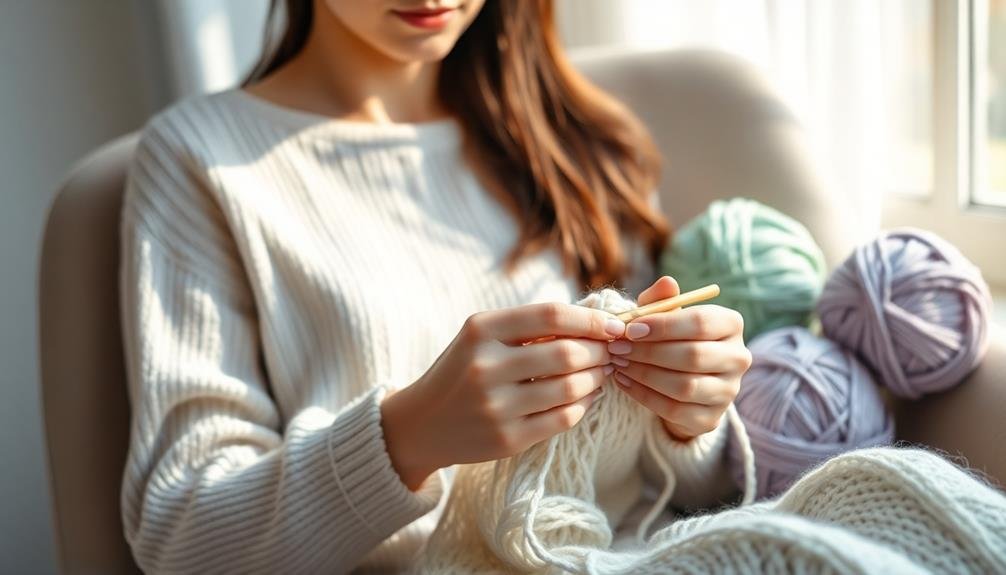
Embracing the power of color, mindful color therapy in knitting offers a soothing and therapeutic experience. As you select yarns, focus on hues that evoke positive emotions and promote relaxation. Cool blues and greens can calm your mind, while warm yellows and oranges may boost your mood.
When knitting, pay attention to how each color makes you feel. Notice the way different shades interact as your project grows. This mindful approach can help you stay present and reduce stress. You'll find that certain color combinations resonate with you more than others, guiding your future project choices.
| Color | Emotion | Effect |
|---|---|---|
| Blue | Tranquility | Reduces anxiety |
| Green | Balance | Promotes harmony |
| Yellow | Optimism | Boosts mood |
| Purple | Creativity | Inspires ideas |
Experiment with color gradients or bold contrasts to stimulate your senses. You might create a "mood scarf" using colors that reflect your daily emotions. This practice not only results in a beautiful finished product but also serves as a visual journal of your emotional journey. By consciously engaging with color during your knitting sessions, you'll enhance the calming effects of your craft and create a more mindful, stress-reducing experience.
Breathing-Synchronized Stitching
Synchronizing your breathing with your knitting rhythm creates a meditative practice that enhances relaxation. As you knit, focus on your breath, inhaling deeply as you insert the needle and exhaling slowly as you complete the stitch. This technique helps you maintain a steady pace and promotes mindfulness, allowing you to stay present in the moment.
To practice breathing-synchronized stitching effectively, follow these steps:
- Begin with a simple stitch pattern to avoid distractions
- Find a comfortable seated position with good posture
- Set a timer for 10-15 minutes to fully immerse yourself in the practice
As you continue, you'll notice your breathing and knitting naturally fall into sync. This harmonious flow can greatly reduce stress and anxiety, promoting a sense of calm and well-being.
You'll find that your mind becomes clearer and more focused, allowing you to let go of intrusive thoughts and worries.
With regular practice, breathing-synchronized stitching can become a powerful tool in your stress-management toolkit. You'll develop a deeper connection between your body, mind, and craft, transforming your knitting sessions into a restorative and rejuvenating experience.
Grounding Through Cable Work
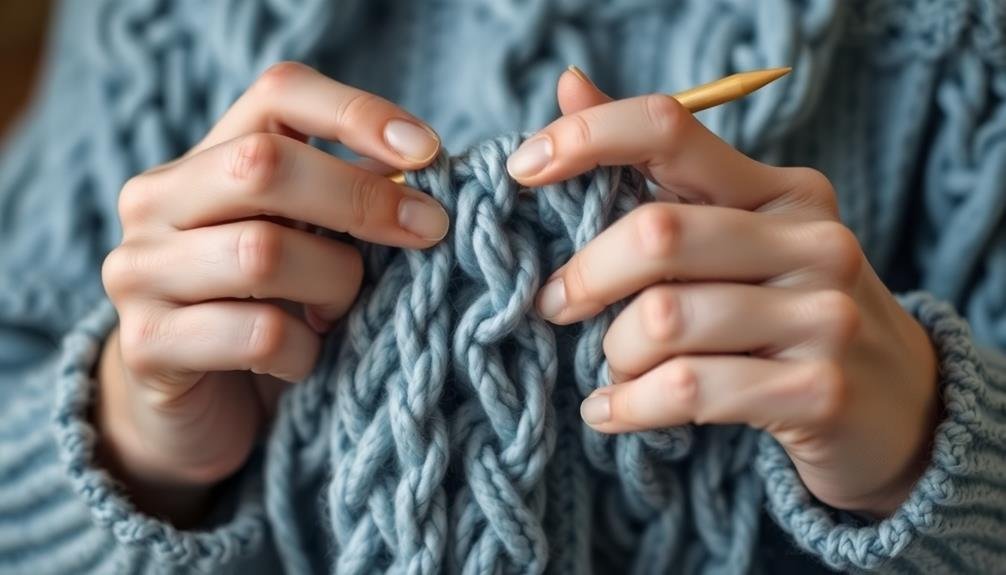
Cable work offers a unique opportunity for grounding in your knitting practice. This intricate technique requires focus and attention to detail, helping you anchor your mind in the present moment. As you manipulate stitches to create twists and braids, you'll find yourself fully immersed in the process, leaving little room for anxious thoughts.
To begin, choose a cable pattern that matches your skill level. Start with simple 2×2 or 3×3 cables before progressing to more complex designs. As you work, pay close attention to the rhythm of your hands and the feel of the yarn. Notice how the fabric transforms with each cable cross, creating depth and texture.
Embrace the meditative aspect of cable work by counting your stitches and rows. This practice keeps you focused and helps maintain an even tension throughout your project. If you make a mistake, use it as an opportunity to practice patience and problem-solving.
Frequently Asked Questions
Can Knitting Help With Anxiety Disorders or Only General Stress?
Knitting can help with both anxiety disorders and general stress. You'll find it's an effective tool for managing symptoms, promoting mindfulness, and providing a sense of control. It's a versatile coping mechanism that you can easily incorporate into your daily routine.
How Long Should a Calming Knitting Session Last for Optimal Stress Relief?
You'll find ideal stress relief in 15-30 minute knitting sessions. However, if you're enjoying it, don't stop! Listen to your body and mood. You'll know when you've had enough calming knitting time.
Are Certain Yarns or Needle Materials Better for Relaxation Knitting?
You'll find natural fibers like wool or cotton more soothing to touch. Wooden or bamboo needles are quieter and warmer than metal ones. Choose materials that feel good in your hands for the most relaxing knitting experience.
Can Knitting Be Combined With Other Stress-Reduction Techniques Like Aromatherapy?
Yes, you can combine knitting with aromatherapy for enhanced relaxation. Try using scented candles or essential oil diffusers while you knit. You'll create a calming atmosphere that engages multiple senses, potentially increasing the stress-reducing benefits of your knitting session.
Is It Possible to Over-Knit and Cause Stress Instead of Relieving It?
Yes, it's possible to over-knit and cause stress. If you're obsessing over projects or pushing yourself too hard, you'll lose the relaxation benefits. Balance is key. Take breaks, switch projects, and listen to your body's cues.
In Summary
You've now explored seven calming knitting methods to help ease your stress. Whether you're drawn to the simplicity of garter stitch or the complexity of cables, there's a technique that'll suit your needs. Remember, it's not just about the finished product; it's about the journey. As you practice these methods, you'll find yourself more relaxed and centered. So pick up those needles, breathe deeply, and let the soothing rhythm of knitting wash over you.

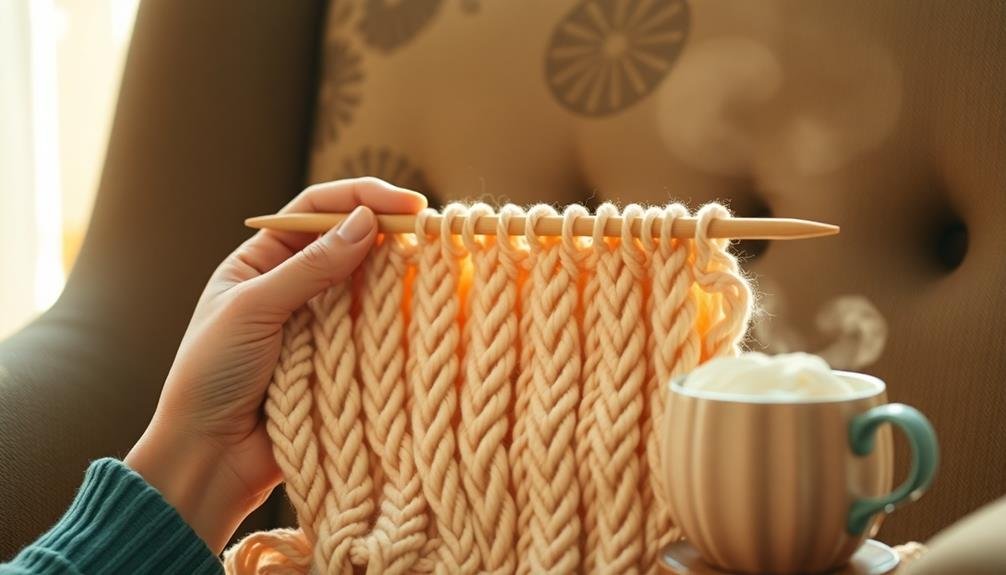



Leave a Reply